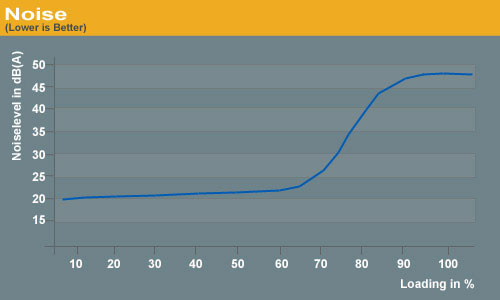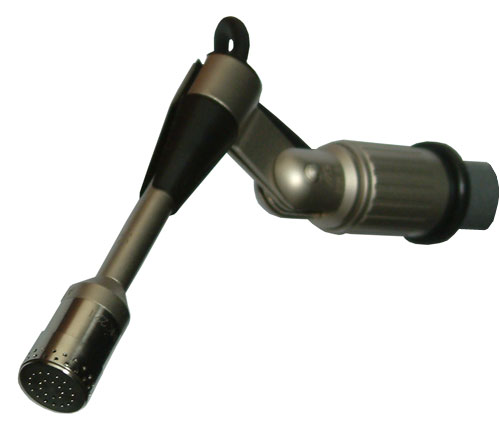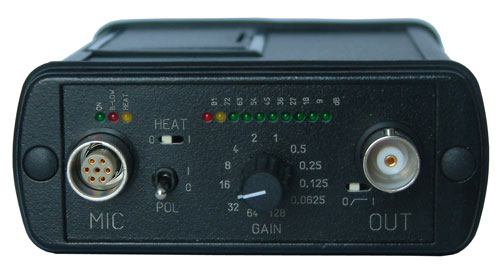AnandTech Power Supply Test Methodology
by Christoph Katzer on July 12, 2007 12:00 AM EST- Posted in
- Cases/Cooling/PSUs
Fan Speed and Resulting Sound Pressure Level (SPL)
The fan speed and the actual temperature of the heatsinks are completely dependent on each other. If the fan(s) turn slowly the heat inside of the power supply will increase as there will be a lack of heat dissipation from the heatsinks. However, the sound pressure level will drop. Conversely, if the fan speed increases the temperatures get better inside the power supply, because the airflow helps to dissipate the heat. The difficulty comes in balancing the desire for lower temperatures with a competing desire for lower noise levels.
Some companies use slower rotating fans in their power supplies to promote quiet/silent products; unfortunately, they don't mention anything about heat levels that can increase tremendously. The fan of the power supply is not only there to cool down the unit itself but also to help exhaust air from the PC. If you have a very slow rotating fan installed the heat of the system will increase, which increases the heat in the power supply as well. The result is a generally hotter system - hotter CPUs, GPUs, hard drives, memory, etc. - and a very sweaty power supply with drooping DC voltages. This, incidentally, is one of the advantages OEM PCs have over their DIY siblings: the OEM is in control of all aspects of the system, and thus is able to determine an optimal configuration of fans, PSU, etc. The best custom-built PCs should take a similar approach, and simply looking for silence without regards to temperatures can lead to unwanted results.
Companies that promote silent power supplies need to have a very good architecture for the printed circuit board and very high-quality components on it. If they skimp in either area, the components are certain to fail at some point. A good indication of a PSU that generates less heat is the stated efficiency. The more efficient a power supply is working, the less heat will need to be dissipated through the coolers. A few years ago such high-quality designs were uncommon at best but companies wanted to have silent power supplies. The result was that most of the units failed after a short time because of overheating.
The art each company needs to master is running the fan speed at an acceptable noise level. There are companies that don't say a word about it and others which stick to their policy that a healthy power supply is a cooled power supply. One of the latter companies is Enermax which says that they know they don't have the quietest power supplies because they prefer the fan(s) to cool the unit to a level that prevents heat-related failures. The user can be sure whey will get very good heat dissipation, but they will also need to get used to increasing noise levels when fully loaded.
To get an impression of how the fan contributes to the cooling of the power supply as well as the resulting noise levels we will test several features. First we measure the actual fan speed in rotations per minute (RPM). This is done with our digital RPM measuring instrument that uses a laser to detect the passing of a white dot placed on the blades, and the frequency is then converted into RPMs.

Sample Fanspeed
To measure the produced noise we have build an anechoic room in which we can measure the noise down to just 15 dB(A). There are simply no power supplies (except fanless models) that can reach this level under this sort of test, but at the same time we will be able to differentiate between varying levels of near-silence. In addition to the sound pressure level we will perform a spectrum analysis to show the different levels of noise produced by the fan at various frequencies.

Sample Noise
The Microphone
To get precise measurements of the noise we need something more than your typical headset-microphone. Even with professional microphones there are big differences which can result in a bad reading. There are many kinds of microphones which are totally inappropriate for test measurements of power supplies or other components. Cardioids-type microphones are pretty much useless since they are designed for directional use within a bigger space and not at all for short distances. The only microphones appropriate for these kinds of measurements are free-field microphones.

Our Microphone is a 0.5" free-field condenser measuring capsule from the renowned German specialist Microtech Gefell.

Microtech Gefell is also the manufacturer of our measuring amplifier. It adjusts the dynamic range of the measuring signal to the input dynamic of the connected PC with which we are analyzing the results.
The fan speed and the actual temperature of the heatsinks are completely dependent on each other. If the fan(s) turn slowly the heat inside of the power supply will increase as there will be a lack of heat dissipation from the heatsinks. However, the sound pressure level will drop. Conversely, if the fan speed increases the temperatures get better inside the power supply, because the airflow helps to dissipate the heat. The difficulty comes in balancing the desire for lower temperatures with a competing desire for lower noise levels.
Some companies use slower rotating fans in their power supplies to promote quiet/silent products; unfortunately, they don't mention anything about heat levels that can increase tremendously. The fan of the power supply is not only there to cool down the unit itself but also to help exhaust air from the PC. If you have a very slow rotating fan installed the heat of the system will increase, which increases the heat in the power supply as well. The result is a generally hotter system - hotter CPUs, GPUs, hard drives, memory, etc. - and a very sweaty power supply with drooping DC voltages. This, incidentally, is one of the advantages OEM PCs have over their DIY siblings: the OEM is in control of all aspects of the system, and thus is able to determine an optimal configuration of fans, PSU, etc. The best custom-built PCs should take a similar approach, and simply looking for silence without regards to temperatures can lead to unwanted results.
Companies that promote silent power supplies need to have a very good architecture for the printed circuit board and very high-quality components on it. If they skimp in either area, the components are certain to fail at some point. A good indication of a PSU that generates less heat is the stated efficiency. The more efficient a power supply is working, the less heat will need to be dissipated through the coolers. A few years ago such high-quality designs were uncommon at best but companies wanted to have silent power supplies. The result was that most of the units failed after a short time because of overheating.
The art each company needs to master is running the fan speed at an acceptable noise level. There are companies that don't say a word about it and others which stick to their policy that a healthy power supply is a cooled power supply. One of the latter companies is Enermax which says that they know they don't have the quietest power supplies because they prefer the fan(s) to cool the unit to a level that prevents heat-related failures. The user can be sure whey will get very good heat dissipation, but they will also need to get used to increasing noise levels when fully loaded.
To get an impression of how the fan contributes to the cooling of the power supply as well as the resulting noise levels we will test several features. First we measure the actual fan speed in rotations per minute (RPM). This is done with our digital RPM measuring instrument that uses a laser to detect the passing of a white dot placed on the blades, and the frequency is then converted into RPMs.

Sample Fanspeed
To measure the produced noise we have build an anechoic room in which we can measure the noise down to just 15 dB(A). There are simply no power supplies (except fanless models) that can reach this level under this sort of test, but at the same time we will be able to differentiate between varying levels of near-silence. In addition to the sound pressure level we will perform a spectrum analysis to show the different levels of noise produced by the fan at various frequencies.

Sample Noise
The Microphone
To get precise measurements of the noise we need something more than your typical headset-microphone. Even with professional microphones there are big differences which can result in a bad reading. There are many kinds of microphones which are totally inappropriate for test measurements of power supplies or other components. Cardioids-type microphones are pretty much useless since they are designed for directional use within a bigger space and not at all for short distances. The only microphones appropriate for these kinds of measurements are free-field microphones.

Our Microphone is a 0.5" free-field condenser measuring capsule from the renowned German specialist Microtech Gefell.

Microtech Gefell is also the manufacturer of our measuring amplifier. It adjusts the dynamic range of the measuring signal to the input dynamic of the connected PC with which we are analyzing the results.










49 Comments
View All Comments
crimson117 - Thursday, July 12, 2007 - link
Good point. Just because a certain digital camera fails when it is submerged underwater, it doesn't mean all users should stick to only buying waterproof cameras. You'd still have a great camera, provided you keep it out of the water.
crimson117 - Thursday, July 12, 2007 - link
<quote>The ambient temperature around the power supply will constantly grow with the time of the test. It will be placed in the same set of conditions it will experience in a real system, where the temperature rises over time.</quote>I'm very glad to see this highlighted in your review strategy.
It always irks me when I see temperature scores of heatsinks which don't consider the variable temperature of the cooling substance (the air) that was used!
If you blow hot 90 degree air over something, the best it can do is cool that something to 90 degrees. If you blast a heatsink with cool compressed air, you'd get much lower heatsink temperatures.
Rocket321 - Thursday, July 12, 2007 - link
About that 5 layer box...I re-read that page a couple times but don't get it. How do you connect the PS unit to the programmable load without running a cable through the wall of the box? If I'm reading it right, you are using the internal PCB to reduce the # of cables you run through the wall to a single cable...?
I'm just curious as it wasn't immediatly clear what was going on there.
Otherwise I applaud you for the new branch of quality reviews you're starting. I look forward to the first review!
nrb - Thursday, July 12, 2007 - link
I'm slightly concerned by this statement: I would urge you not to start doing PSU reviews until you have got the measurement of ripple figured out. It's one of the most important measures of PSU performance, IMNSHO.kaborka - Saturday, July 14, 2007 - link
I second that. Measuring ripple on my scope under various loads is the first thing I do when I get a new PSU. I have an old surplus Tektronix I use. I would not be interested in any reviews that don't include ripple measurements -- it would be useless.But Thank You, THANK YOU for finally doing serious PSU tests. The sites that do fluff pieces about the latest shiny boxes have always irritated me no end!
EODetroit - Thursday, July 12, 2007 - link
HardOCP pretty much is the gold standard on real, tough, power supply reviews atm. It will be interesting to see if you get the same results as they do.One thing that happens all the time in the HardOCP reviews is that a PSU will work great up to about 75% of its rating, then fail or get out of spec. My question is... will you consider that a failure or will you just recommend the PSU as long as you don't go over 75% ? No one runs a PSU fully loaded on purpose anyways.
One more thing slightly off topic... how come Anand (and everyone else in the biz) is willing to load a PSU to the max but won't review a motherboard loaded with the maximum "supported" memory? The latter is a much bigger problem imo, and with 64 bit OSes now commonplace that can make use of all the memory in a computer, the time is right to start reviewing MBs that supposedly support 8 GB of ram... while actually loaded with 8 GB of ram.
CrystalBay - Thursday, July 12, 2007 - link
So how is PCP&C's 750 Silencer gonna stack up with it's 80mm fan???End The Power Supply Myths AT........
strikeback03 - Thursday, July 12, 2007 - link
I recently bought some motherboards to build desktop systems for some of our grad students. They claim support for 16GB RAM, but since they only have 2 slots for RAM testing 16GB falls somewhere between "extremely expensive" and "impossible".Martimus - Thursday, July 12, 2007 - link
I would like to see that as well. MB's performance with a full load of RAM. (Actually I would want to know if there are any other issues when you run it like that.)strikeback03 - Thursday, July 12, 2007 - link
Nice new toys:)On the Temperature page where it says "We will start at a room temperature of 77°F (25°C)" perhaps mention should be made that the "room" is actually a sealed box, which appears to have far less air volume (and circulation) than the average room, so the air will get far warmer than it ever should in an actual case.